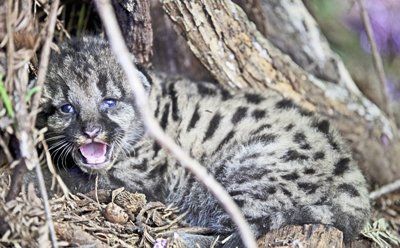
California is the only western state where killing mountain lions is illegal. But that doesn’t mean it doesn’t happen.
Last summer, during a nature walk at Loch Lomond with doctoral students from the University of California, Santa Cruz Puma Project, the participants and I asked about the female lion whose signal we had heard the summer before, as she walked less than a mile from where we were standing.
Yiwei Wang and Veronica Yovovich told us that she had been shot and killed and her collar had been removed.
Sadness enveloped our group. After all, she was our mountain lion, and we had shared an afternoon listening to her GPS signals as she traveled through the canyons near Loch Lomond.
Two other pumas call this area home: a male who was hit by a car on Highway 17 and a female yet to be collared. The male continues to cross the highway, unfortunately, as his territory includes both sides. However, the UCSC trackers have pictures of his almost-healed wound, and he is still defending his land and mating.
GPS signals show when he is meeting up with a female. However, because lions get off the road and into the bushes when mating, there are no xxx-rated pictures of them.
The circle of life keeps turning, and last week the Puma Project tracked a female in Nisene Marks State Park, making a lot of noise to warn her of their presence and move her off her den. They found three 4-week-old kittens — old enough to open their sapphire-blue eyes, but not old enough to run away.
“Four months ago, she had a litter, but they were eaten by a predator. It’s all about competition,” Wang said. “If they remove kittens, they are killing future predators who could kill them.”
Only intestines and paws were found.
“It might have been a male lion, because she mated right away,” Wang said. “Survival rate is less than half until they leave their mom. If they are male, their chances aren’t good, because they have to get far away and they might run into a person, car, or other male.”
The young lions are 14 to 18 months old before they leave their mother and can be collared.
“Sometimes, people have seen a passel of mountain lions, and that’s usually a mom with her full-grown kittens. The males will be larger than her,” Wang said.
Professors and students in the Environmental Studies Department will follow the family’s movements and survival in the coming months.
Working with other organizations, the group is studying what happens when habitat fragmentation caused by housing, roads, and agriculture breaks up wildlife corridors in the Santa Cruz Mountains and the Gavilan, Hamilton and Diablo ranges.
By tracking the big cats, they can determine where cats are crossing Highway 17. Working with Caltrans, they might get funding to build overhead passages or improvements to ancient culverts or even fencing that would funnel wildlife into the underpasses so they wouldn’t be hit by cars.
Recently, Wang and Yovovich decided to check out a certain culvert under 17 to see if pumas were using it for passage.
“I had a headlamp and high-powered flashlight. The culvert was just big enough so I could crawl,” Yovovich said. “If I arched my back, I could hit the top of it. The culvert took a bend under 17, so you couldn’t see from one end to the other.
“For a half an hour, I crawled through on my hands and knees for 50 yards — spiders dropping down on my face, ants, and all these bugs crawling on me. I could see bobcat and raccoon tracks all the way, but I didn’t see any puma signs. I kept wondering if I was going to see an eye shine coming the other way.”
Wang and Yovovich will be taking their cages, collars and GPS equipment on a free walk along Loch Lomond on June 10, a Sunday. This walk is sponsored by an environmental grant from the San Lorenzo Valley Water District.
If you would like to join our merry band, please email me at ca****@*********on.com.
– Carol Carson, M.Ed., is a writer, naturalist and educator











